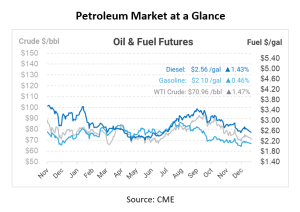
What is it – Federal Open Market Committee (FOMC)
While it might seem unrelated at first glance, the Federal Open Market Committee (FOMC) influences the petroleum market and, by extension, oil and gas prices. Its primary goal is to manage the U.S. economy through the levers of money supply and interest rates, although its decisions reverberate through the global economy, affecting commodity markets and energy prices. Understanding the relationship between the FOMC’s actions and the petroleum market is essential for investors, policymakers, and anyone interested in the dynamics of the global economy. Today’s What is it Wednesday article delves into the nature of the FOMC, its functions, and its indirect but notable impact on the energy sector.
What is the FOMC?
The Federal Open Market Committee (FOMC) is a crucial component of the Federal Reserve System, the central banking system of the United States. Established under the Banking Act of 1933, the FOMC is the body responsible for overseeing the nation’s open market operations. The FOMC comprises twelve members – the seven members of the Board of Governors of the Federal Reserve System, the president of the Federal Reserve Bank of New York, and four of the remaining eleven Reserve Bank presidents, who serve on a rotating basis. The Committee meets eight times a year to review economic and financial conditions, determine the appropriate stance of monetary policy, and assess the risks to its long-run goals of price stability and sustainable economic growth.
Primary Functions of the FOMC
The primary function of the FOMC is to regulate the growth of the money supply and achieve a set of goals prescribed by Congress: promoting maximum employment, stabilizing prices, and moderating long-term interest rates. The FOMC accomplishes these goals primarily through open market operations, which involve the buying and selling of government securities.
Impact on the Petroleum Market and Oil and Gas Prices
The actions of the FOMC can significantly influence the petroleum market in several ways. From influencing inflation rates and economic demand to affecting exchange rates and investor sentiment, the FOMC’s policies serve as a critical factor in shaping the trends and fluctuations in the oil and gas markets. Below are a few ways in which the FOMC has an impact on the energy sector:
Monetary Policy and Inflation: The FOMC’s decisions on interest rates and money supply can affect inflation, which in turn impacts the prices of commodities, including oil and gas. For instance, if the FOMC adopts an expansionary monetary policy, leading to lower interest rates, it can stimulate economic growth but also risk higher inflation. Higher inflation can lead to increased oil and gas prices as the value of the dollar declines, making commodities priced in dollars more expensive.
Economic Growth and Demand: The FOMC’s policies also indirectly affect the demand for oil and gas. When the FOMC takes measures to stimulate the economy, it can increase industrial activity and consumer spending, thereby raising the demand for energy. Conversely, contractionary policies can slow down economic growth and reduce the demand for oil and gas.
Exchange Rates: The FOMC’s decisions influence the U.S. dollar’s value in the foreign exchange markets. A stronger dollar makes oil more expensive for foreign buyers, which can reduce global demand and put downward pressure on oil prices. In contrast, a weaker dollar can make oil cheaper in foreign currencies, potentially increasing global demand and pushing prices up.
Investor Sentiment: The FOMC’s policy announcements can affect the financial markets, including commodity markets. Investors often react to these announcements by adjusting their expectations about economic growth and inflation, which can lead to short-term volatility in oil and gas prices.
Past and Future Implications for Fuel Buyers
In the past year, the Federal Reserve’s (Fed) decision to hike interest rates has had a multifaceted impact on the petroleum market, particularly on oil prices. These interest rate hikes, part of the Fed’s strategy to combat rising inflation and stabilize the economy, have led to higher oil prices. The anticipation or announcement of interest rate hikes can lead to speculative trading in oil futures. Traders often react to the Fed’s policy decisions by adjusting their expectations for economic growth and inflation, which can lead to volatility in oil prices. If the market perceives the Fed’s actions as a precursor to an economic slowdown, this could lead to a bearish outlook on oil demand and prices.
While the Fed’s policies are primarily aimed at the US economy, they have global implications, given the interconnectedness of the world economies. Other countries’ central banks might respond to the Fed’s rate hikes by adjusting their own policies, which can further influence global economic conditions and, consequently, the demand and prices of oil on a worldwide scale.

This article is part of Daily Market News & Insights
Tagged:
MARKET CONDITION REPORT - DISCLAIMER
The information contained herein is derived from sources believed to be reliable; however, this information is not guaranteed as to its accuracy or completeness. Furthermore, no responsibility is assumed for use of this material and no express or implied warranties or guarantees are made. This material and any view or comment expressed herein are provided for informational purposes only and should not be construed in any way as an inducement or recommendation to buy or sell products, commodity futures or options contracts.





